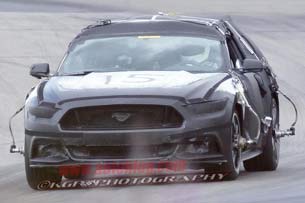
Those engineers work with from the beginning to identify key attributes the company wants to hide, said Farah. "We agree there are certain aspects of the vehicles we want to work hardest to camouflage and we will develop a package to address those areas," he explained. In the earliest testing, new hardware might run beneath an existing car's bodywork – known as a mule – just to sort out fundamentals. But as the car progresses toward production, it is important to test it in increasingly complete form, Farah said.
When the new bodywork is fitted, at first engineers cover it with hard plastic and soft foam, to bury it out of sight. Later, that has to be peeled off for more realistic testing of things like aerodynamics and wind noise, so carmakers apply checkerboard-patterned adhesive vinyl to try to "fool the eye into not seeing what is there," said Pericak.
That early bulkier padding hides the car effectively, but it also interferes with testing, especially for a fast car like the Mustang. "I can't drive 155 miles per hour with the camouflage on the car," he noted.
But even cars wrapped in padded cladding can reveal useful information about upcoming models, according to veteran lenswoman . "Window glass and rooflines are often telltale signs of things to come," she tells Autoblog.
Once all the testing can be done with the padding attached is complete, that means stripping down to just patterned vinyl wraps. This is where new car development meets the body paint section of 's annual swimsuit issue, with readers poring intently over photos, trying furiously to discern what lies beneath.
No comments:
Post a Comment